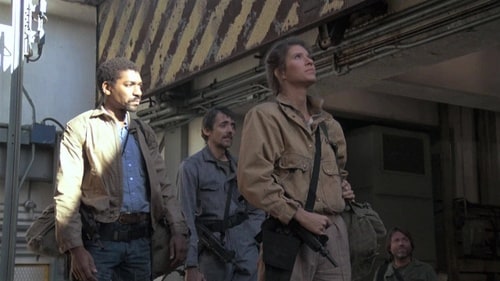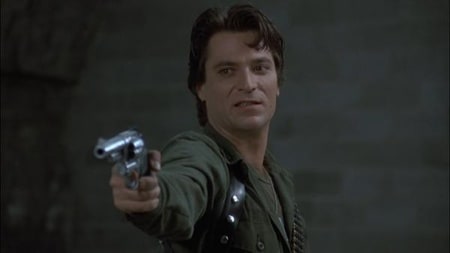The third instalment in director George A. Romero's undead franchise, 1985's Day of the Dead was intended to be the Gone with the Wind of zombie movies, with an ambitious story and epic scope. However, the budget was slashed from $7 million to $3.5 million by nervous financiers concerned about the film's gory content, with Romero hesitant to conform to the limitations of an R rating (how quaint, looking back), and with executive producer Salah M. Hassanein unwilling to fund an unrated film. The screenplay was therefore rewritten in line with the budget cuts, in the process compromising Romero's initial vision. Even though Day of the Dead is not a genuinely epic zombie extravaganza, the finished film is nevertheless hard to dislike. Although the scope is restricted, ample funds were available for the special effects - and consequently, this is a vehemently old-school, insanely violent horror film with the most impressive zombie make-up of its era, while the script is beset with thoughtful thematic content.

Picking up an unspecified time after 1978's Dawn of the Dead, the zombie infestation has only intensified and grown - for every living human on the planet, there are four hundred thousand zombies. Day of the Dead finds a number of survivors in an underground Floridian bunker, where scientists cohabitate with armed military personnel. The science team, led by Dr. Logan (Richard Liberty) and including Dr. Sarah Bowman (Lori Cardille), is conducting experiments on undead bodies in the hope of finding a cure, or at least another way to deal with the growing zombie numbers. However, the soldiers, led by the antagonistic Captain Rhodes (Joseph Pilato), are becoming impatient, and sanity levels are rapidly declining due to the confined space and ostensible lack of hope for the future.
Although zombie movies are usually brainless endeavours, Romero creates cautionary fables about societal malaises, buttressing the material with satire. Night of the Living Dead concentrated on the unrest emerging from the civil rights movement, and reflected the era’s growing fear of invasion by foreign forces. Dawn satirised materialism, viewing crass commercialism as a mindless escape from reality and a new drug of choice. Day of the Dead, meanwhile, is a product of the Regan era, with Romero setting his sights on the military and creating a doomsday prediction of life in the not-too-distant future. The tone here is darker and more dour than its predecessors, disposing of the almost slapstick feel that permeated Dawn of the Dead. Due to the budget cuts, Day mostly takes place within the labyrinthine underground facility, similar to Dawn's shopping mall setting. However, the mood here is more hopeless and the zombies are not the only threat, as the human characters begin to turn on one another. Romero posits that although some humans may still be alive during a zombie apocalypse, the undead still win if they destroy the soul of humanity.

Day of the Dead is backed by conceptual intelligence, but it is still an entertaining movie driven by visceral bloodshed and gore, with Romero never skimping on the nasty details. Without a doubt, this is make-up and special effects artist Tom Savini's artistic masterpiece. Savini is a long-time special effects champion, and he lets his war-scarred imagination run wild here (he was a combat photographer in Vietnam). As a result, Day of the Dead is viciously gory, with an unsettling attention to anatomical detail - we get a person's face being torn off by the eyelid, a head being cut in half with a shovel, and zombie fingers prying open living humans to pull out the gooey viscera inside. The zombies themselves look outstanding too, exhibiting convincing deterioration and decay. Additionally, some of the zombies are missing limbs, while another is entirely cut open on an operation table. Other elements of the special effects still impress to this day, including the terrific practical blood squibs. Furthermore, Romero's direction is expectedly competent, driving the mayhem and staging the action set-pieces with a sure hand. If there is a shortcoming, it's the synth score by John Harrison, which noticeably dates the film. Romero's vision needed a stronger musical accompaniment.
Admittedly, the characters inhabiting Day of the Dead are not exactly likeable or sympathetic; virtually everybody here is an over-the-top cartoon, from the mad doctor to the insane, trigger-happy soldiers. But aside from the sheer entertainment value of these caricatures, it is a credible portrayal of this type of situation - with the world in a post-apocalyptic state, the only people left alive are either rational or crazy. Pilato is the standout in terms of acting; his character of Captain Rhodes is memorably unhinged and rich in personality, yet he is also arguably the film's real hero. After all, he is right about the futility of surgery to "domesticate" the zombies, and the facility's security is ultimately threatened because of the scientists. Rhodes is mad and unsentimental, but that is precisely why he survived for so long. Meanwhile, Cardille is a strong and charismatic female lead, while solid support is provided by Terry Alexander as the rational helicopter pilot. Gary Howard Klar also warrants a mention; he's over-the-top and fun as one of the crazed soldiers. But perhaps the strongest performer here is Sherman Howard as Bub, a zombie in the process of becoming domesticated through scientific experiments. Howard looks like a brainless zombie at first glance, yet he also nails the role's more complex nuances. It's a quality performance, making Bub the most sympathetic character in the film.

Due to the screenplay changes necessitated by budget cuts, Day of the Dead is a polarising film that is seen as either a fan favourite or a missed opportunity. The movie certainly struggled to find its audience when released in 1985, with disappointing box office to boot, but it found second life on home video. Although it's lamentable that Romero could not accomplish his original vision, Day of the Dead is great for what it is: another bold portrayal of the zombie apocalypse that's creepy, frightening and gory. Romero's view of humanity here is detached and cynical, the film is full of scenery-chewing lunatics, and Savini's special make-up effects remain simply astonishing to this day. It adds up to another masterpiece in this reviewer's mind, though Day of the Dead is not for all tastes.
7.7/10
 Login
Login
 Home
Home 183 Lists
183 Lists 1670 Reviews
1670 Reviews Collections
Collections
 0 comments,
0 comments, 
































